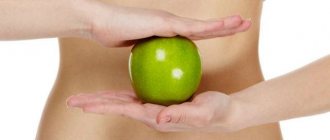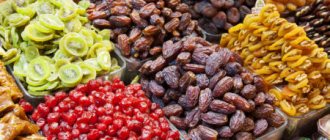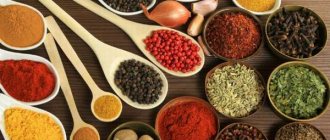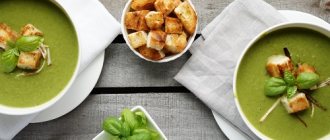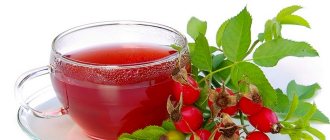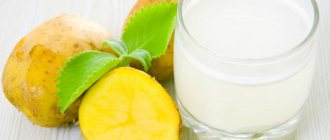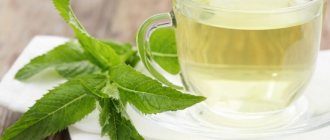How to cook baked apples in a slow cooker
Baked fruits are more useful for those suffering from pancreatitis, since during heat treatment they change their properties, becoming softer, without irritating the walls of the mucous membrane.
Even in the remission stage, the patient prefers baked apples to fresh ones. They can be baked and consumed not only as an independent dish, but also in combination with other foods acceptable for pancreatitis. It is acceptable to use honey, raisins, cottage cheese, cinnamon, jam and other healthy ingredients for the filling.
Baked apples are prepared as follows:
- rinse the fruits;
- cut off their top part;
- remove the cores using a spoon;
- fill the empty cavity of the fruit with any of the required fillings;
- cover them with the cut top;
- bake in the oven for 15-20 minutes at 180-200° C.
Possible fillings for baked apples in the presence of pancreatitis can be:
- A mixture of walnuts and raisins, to which you can add a little honey and cinnamon.
- Curd base. For 10 fruits you need to take 500 g of cottage cheese and mix it with 2 eggs. Add 2 tbsp. spoons of sugar, raisins, cinnamon (a teaspoon each), some nuts.
- Pumpkin filling. For half a kilogram of apples you will need about 200 g of grated pumpkin, cinnamon, sugar - 2 tbsp. spoons. Served as a main dish or in combination with rice.
Continue baking until the apple peel bursts. Those with thicker skins take longer to cook. The finished baked fruits are a product that is somewhat “bruised” on the outside and has a soft inside. They can be consumed warm, but they have a better effect on the pancreas when completely cooled.
Not all apples are equally beneficial for pancreatitis, but by choosing those varieties that are acceptable for such a disease, the patient can consume this tasty fruit within reasonable limits, giving preference to baked fruits.
The benefits of fruits have long been proven by nutritionists.
- With regular consumption, the level of cholesterol in the blood decreases.
- Due to the pectin content in fruits, apples normalize stool character and prevent the development of constipation.
- The vitamin G contained in the fruit improves appetite in patients.
- Eating the product is an excellent prevention of vitamin deficiency.
- The high content of iron ions in fruits prevents and treats iron deficiency anemia.
- People whose activities require increased mental stress are recommended to include fresh apple juice in their diet.
- It is useful to eat the fruits for those suffering from insomnia and increased nervous excitability. Eating apples improves mental and physical performance.
- According to scientific materials, fresh apple juice exhibits a rejuvenating effect.
- The antimicrobial properties of the fruit prevent the development of caries.
- Baked fruit cleanses the intestines and removes toxins from the body.
- Apples are low in fat, low in calories, combined with a high content of microelements and vitamins.
Despite the long list of beneficial properties, it is necessary to use apples with pancreatitis with caution, preferably under the supervision of a physician.
Baked apples are recommended for use for pancreatitis. Unlike fresh fruits, there are no restrictions in such a dessert; they begin to be consumed much earlier. The heat treatment to which fruits are subjected changes the properties of the fruit and its effect on the human body. Apples cooked in the oven or microwave become sweet and soft, and there is no irritation of the mucous membrane of the stomach and intestines.
Baked apples should be eaten not hot, preventing irritation of the mucous membrane of the stomach and intestines. It is better to wait until the fruit reaches a comfortable temperature.
You can cook an apple in the oven along with pumpkin or other fruits - apricot, pear. The fruits are first thoroughly washed, peeled and pitted. The core is carefully cut out and filled, for example, with low-fat cottage cheese with the addition of raisins or honey.
Fruits filled in this way are laid out on a special baking sheet and placed in the oven for 20 minutes at a temperature of 180 degrees. Instead of the oven, you can put the fruit in the microwave.
The mentioned apple dessert, allowed for consumption in pancreatitis, will diversify the patient’s limited table and will bring considerable benefits.
However, when consuming this product, despite the high content of beneficial substances, you should remember some harmful features for patients with pancreatitis:
- high content of organic acids (increased acidity provokes inflammation);
- low calorie content (because of this, patients may abuse the product);
- solid structure (complicates the digestion process during the acute period of the disease);
- Excess fiber (causes bloating).
| Nutrients | Value (grams) |
| Squirrels | 0,4 |
| Fats | 0,4 |
| Carbohydrates | 11,3 |
| Calorie content per 100 g | 53 Kcal |
These fruits will be beneficial only for those patients who know how to prepare and eat them correctly. Otherwise, they can cause harm and cause the disease to worsen.
Baked apples have a beneficial effect on the body, which is fragile after inflammation, are easily digested, and help saturate the body with useful substances and microelements. When cooked in the oven or microwave, apples become sweet and soft.
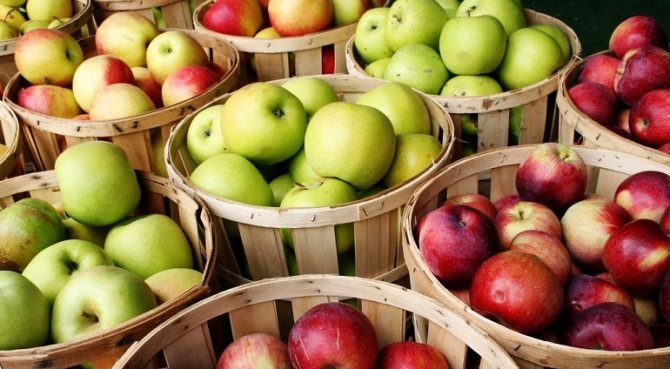
You can bake apples empty or with filling, which can be apricots, pumpkin, pears, low-fat cottage cheese with honey or raisins. Apples prepared in this way must be cooled before use to avoid irritation of the mucous membranes of the digestive system.
You can cook an apple in the oven along with pumpkin or other fruits - apricot, pear. The fruits are first thoroughly washed, peeled and pitted. The fruits are laid out on a special baking sheet and placed in the oven for 20 minutes at 180 degrees. Instead of the oven, you can put the fruit in the microwave.
The use of baking technology leads to a decrease in the content of organic acids in fruits; eating them will not lead to such irritation of the mucous membrane of the gastrointestinal tract, or an increase in the secretory activity of the pancreas, as from fresh fruits.
If you bake apples, it will be much easier for the body to absorb them, despite the drop in the enzymatic activity of the pancreas, and supply the body with a large amount of vitamins and carbohydrates from these fruits.
Such processing of fruits saturates them with pectin - a soluble form of fiber, leading to normal indicators of the ratio between various forms of saprophytic microorganisms living in the intestinal lumen, cleansing the body of some toxins and “bad” cholesterol, carefully enhancing peristalsis, eliminating constipation, and facilitating the functioning of the gallbladder.
When stable remission is achieved, the patient's diet can be varied with apple pies, which should contain as little sugar as possible.
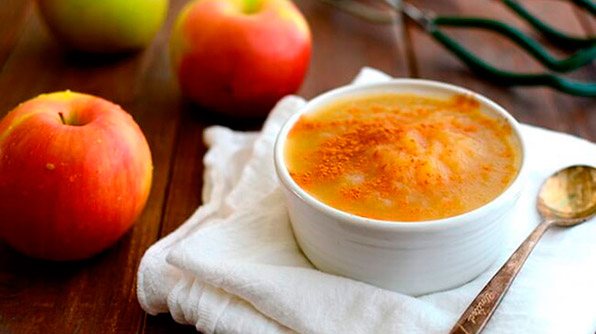
Factory-made baked goods for patients with pancreatitis are prohibited, however, you can afford to make your own. But the following conditions must be met:
- prepare them yourself using a minimum amount of sugar;
- baked goods must be fresh;
- eat such foods in small quantities.
High-temperature processing of apples changes not only their chemical composition, but also their taste properties - they become more soft and sweet. At the same time, the amount of such a useful microelement as iron remains unchanged.
However, if you eat a freshly baked dish, you can harm yourself due to the negative impact of hot food on the gastric mucosa.
Is it possible to eat baked apples with pancreatitis? You can - the main thing is to know what harm even baked apples can cause to patients with pancreatitis.
At the very beginning, it is worth baking the fruits without sugar, spices and other additives. Honey in this case does not count, since on the contrary, it has the most positive effect on the entire work of not only the gastrointestinal tract and pancreas, but also filling the body with vitamins and essential macro and microelements.
Choose sweet and ripe fruits, whole and unspoiled, and baked apples are contraindicated only for the first few days of exacerbation of pancreatitis, or you are allergic to them.
The patient should not overeat. A special dietary diet provides for no more than 2 apples per day, which is taken as the norm.
In case of acute pancreatitis, baked apples should be introduced into the diet several days after the onset of the attack. Apple juice or puree - no earlier than a week after the attack worsens.
When diagnosing a chronic form of pancreatitis, you should not eat more than 2 apples per day, adding them to the diet, grated or baked.
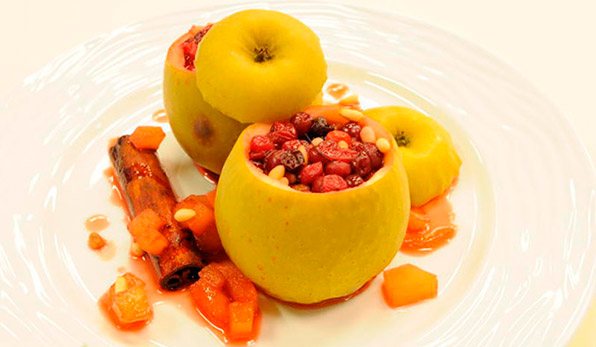
This dish can be an excellent dietary dessert, which in addition to taste pleasure will bring certain benefits to the body.
Sweet apples with green skin should be washed thoroughly.
The core of each fruit must be carefully removed: try not to make a through hole, otherwise the filling may leak out.
For stuffing, mix steamed raisins and finely chopped dried apricots. Add a small amount of natural honey to the resulting mixture.
We fill each fruit with the resulting filling, place it on a baking sheet and put it in the oven for 15-20 minutes.
Let the finished dish cool slightly and you are ready to eat.
The benefits of baked apples for pancreatitis are great. Due to slight heat treatment, plus due to the fact that they are baked in the peel, they retain almost all the vitamins, a huge amount of useful macro and microelements.
Speaking about whether it is possible to eat baked apples for pancreatitis, doctors strongly recommend introducing them into your diet. And the point in this case is that the following beneficial properties of baked fruits are of great importance for patients:
- During the baking process, the acidity level in the fruits decreases, and unlike fresh apples, they will not irritate the gastrointestinal mucosa, causing increased pancreatic activity and secretion production.
- In this form, apples are easier to digest and even with a reduced level of enzymes produced by the pancreas, filling the body with necessary carbohydrates and vitamins.
- Baked fruits are rich in pectin - soluble fiber, which normalizes the balance of intestinal microflora, helping to remove toxins and bad cholesterol, gently activating peristalsis, and fighting constipation.
- In case of acute pancreatitis, baked apples should be introduced into the diet several days after the onset of the attack. Apple juice or puree - no earlier than a week after the attack worsens.
- When diagnosing a chronic form of pancreatitis, you should not eat more than 2 apples per day, adding them to the diet, grated or baked.
The benefits of apples
It is important to understand that apples are useful not only for pancreatitis. The list of positive properties of this fruit is incredibly wide, and here are just a few of them:
- due to the presence of pectin, these fruits significantly reduce the risk of diarrhea;
- contribute to the disappearance of nausea and vomiting;
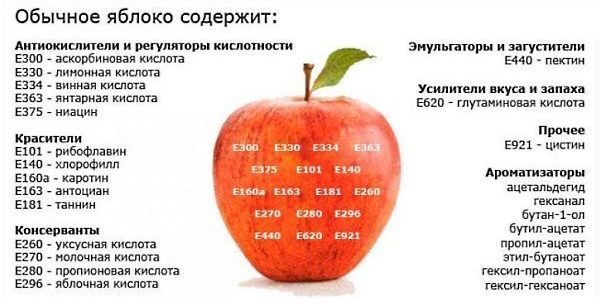
- apples help lower cholesterol levels;
- fruits improve appetite;
- they are rich in iron;
- Constant consumption of fruits has a positive effect on intestinal function;
- The fruits also help cope with vitamin deficiency, since they contain a significant amount of microelements and vitamins;
- These fruits increase mental abilities.
This product really has a lot of positive properties. Thus, scientists were able to prove that apples stop the aging process. They have a positive effect on digestion and saturate the body with useful microelements.
However, they need to be used wisely as part of the daily diet, especially if a person suffers from pancreatitis.
What fruits are allowed for pancreatic pathology?
If a patient's chronic pancreatitis is in remission, eating fresh fruit is allowed. Opt for sweet, ripe green apples. If the fruit is colored red, it is better to eat it baked to avoid complications. The dyes contained in the skin are considered strong allergens and can worsen the patient’s health.
During the remission stage, it is permissible to eat the product in moderate quantities. If you allow overeating, the pancreas simply cannot cope with the load, which will negatively affect the patient’s health. Excessive fiber in fresh fruit will cause bloating. If the disease worsens, it will lead to significant deterioration.
It is unacceptable to eat unripe fruits with a sour taste if you have pancreatitis. Before eating, the apple must first be peeled. You are allowed to eat 2 fruits per day. Not recommended on an empty stomach. You can eat an apple fresh or baked after a light breakfast, dinner, or as a dessert.
If the disease is in the acute stage, eating fresh apples is not recommended. It is better to limit yourself to baked fruits.
Apple varieties containing large amounts of organic acids can exacerbate pancreatitis. For this reason, not all juices can be prepared freshly. Only sweet varieties are suitable for this:
- Saffron;
- White filling;
- Golden Delicious.
However, fresh apple juice can only be prepared from fully ripe fruits. As for the product from the store, it must contain one of the preservative substances:
- citric acid;
- sodium benzoate;
- sorbic acid.
They can irritate the pancreas. For this reason, patients are prohibited from giving factory-made juice, only freshly prepared juice with a minimum pulp content.
Use for fresh eating or preparing dishes and drinks as part of a prescribed diet should only be: well-ripened soft fruits; no damage or mold; sweet varieties; not subjected to chemical treatment during collection and storage; thoroughly washed to neutralize nitrates; peeled to remove coarse dietary fiber. Fruits are best consumed during the high season when their nutritional content is at its highest.
Raw whole apples are allowed to be eaten only during the period of remission, choosing those with green skin. Patients can consume “red-skinned” fruits only after they have undergone heat treatment, since they can cause an exacerbation of inflammation of the gland. And even then, a few apples are allowed, as they provoke excessive gas formation.
The best solution is to peel ripe fruits before eating.
This dish can be used to diversify the menu of even a patient with acute pancreatitis after only 5 days have passed from the onset of the disease, and it will not cause a worsening of the person’s condition.
To prepare the dish, you can use a slow cooker, microwave (up to 10 minutes, power 800 W) or oven (up to half an hour, temperature up to 180 degrees Celsius).
You can determine the readiness of the fruit by the degree of its softening. After the apple has cooled, it should be freed from the skin and core, then beat the resulting slices using a blender and serve.
When diagnosing pancreatitis, when the pathology is in remission, gastroenterologists recommend eating fresh fruits and vegetables, in particular apples, fresh. Moreover, this applies exclusively to their green varieties.
When asked by patients - is it possible to eat baked apples with pancreatitis, nutritionists give a positive answer, emphasizing that only sweet varieties should be chosen for this.
The thing is that the pancreas, which works with disturbances, is not able to physically cope with a large amount of fresh fruit. But a baked apple introduced into the diet for pancreatitis will not put an excessive load on this gland and will dilute the daily menu.
Gastroenterologists advise choosing green, sweet varieties of apples, limiting consumption to 1-2 fruits per day.
At the same time, you should not even eat a baked apple with pancreatitis on an empty stomach, not during an exacerbation of the disease.
When it comes to the question of which fruits to choose, we can conclude that if you have inflammation of the pancreas, you should choose peeled apples, sweet and green varieties, and ripe ones.
There are several conditions, observing which, the patient can eat this fruit.
For example, the use of sweet varieties, as well as those with yellow or green peel, is allowed. Red fruits are prohibited, as their action greatly irritates the pancreas. You should not eat apples with peel, which is a source of coarse fiber, which is undesirable for consumption in the presence of pancreatitis.
An important condition for including fresh fruits in the menu is to limit their quantity. Patients should not eat more than one medium-sized fruit at once, and this can only be done if pancreatitis is in remission.
Thus, apples with pancreatitis are possible for the patient, provided:
- persistent remission of the disease;
- peeling them;
- using sweet and ripe fruits;
- pre-eating other food;
- compliance with consumption standards (no more than 1-2 fruits, depending on their size).
If a patient's chronic pancreatitis is in remission, eating fresh fruit is allowed. Opt for sweet, ripe green apples. If the fruit is colored red, it is better to eat it baked to avoid complications. The dyes contained in the skin are considered strong allergens and can worsen the patient’s health.
Nutritionists do not advise patients with pancreatitis to purchase Antonovka apples with an increased amount of organic acids, which negatively affect the condition of the pancreas and stomach. It is recommended to eat Saffron, Golden, White filling for pancreatitis. The varieties have a suitable taste and do not contain coloring pigments in the skin.
Apples for pancreatitis are recommended to be consumed exclusively in the remission stage. In the acute stage, fresh fruits are strictly prohibited during the first 24 hours. If your condition improves after 2 days, start drinking juice from sweet fresh apples diluted with clean water in small doses. Drinking store-bought apple juice is unacceptable.
After a week, the patient is allowed to eat a whole apple, baked or pureed. If the disease has entered the stage of stable remission, eating a whole apple daily is allowed.
In the chronic form of the disease, it is allowed to eat apples in limited quantities. It is better to process fruits before eating. Cook compotes from sweet fruits, prepare mousses or jelly. A light dish would be apple puree.
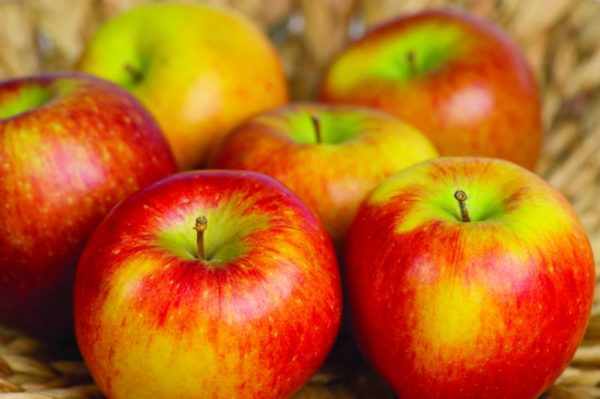
Baked apples have an enveloping effect for pancreatitis and prevent the development of constipation. It is not recommended to consume jams and marmalade due to their high sugar content, which is harmful to the pancreas.
It is not recommended to eat varieties with a high amount of acid for gastritis and pancreatitis. Such fruits are acceptable baked or boiled. When the disease is in stable remission and the patient has no complaints, consuming fresh apples is useful to replenish the supply of trace elements and minerals in the patient’s body. The fruits contain potassium and magnesium ions, which are vital for normal metabolism.
Fresh apples contain plant fiber. The polysaccharide is slowly absorbed in the body, eliminating the feeling of hunger for a long time.
What fruits should you eat for pancreatitis?
If the symptoms disappear for a certain period of time, it is necessary to expand the patient’s daily menu to the maximum and include fruits and vegetables.
It is optimal when the choice is made in favor of seasonal fruits, since they can be taken fresh, removing the skin and core.
The most suitable dessert for patients would be dried fruits, from which compotes are made.
- Apples, in the presence of the pathology in question, are considered the most harmless products for patients. They are prepared baked. Before eating fresh fruit, you need to remove the skin and pull out the middle. It is optimal to avoid winter varieties due to the fact that they are characterized by a coarse consistency.
- It is acceptable to eat pears and certain berries from which fruit drinks are made. Apple and pear puree can be eaten after 4 days, when the exacerbation ends. The same applies to bananas. Banana pulp does not require any additional processing.
- During the remission stage, tangerines and oranges are consumed in small pieces. It is not recommended to drink grapefruit and citrus juices due to the fact that they contain a high concentration of acidity. It is acceptable to eat a couple of pieces of melon and pineapple.
- It is also allowed to eat feijoa. Due to the increased concentration of vitamin B, the fruit has a positive effect on the diseased organ.
- Among the variety of berries, the patient is allowed to drink rosehip decoction at different stages of the disease. Cranberries are prohibited for consumption at the stage of exacerbation of pancreatitis. It affects the production of gastric juice, which aggravates inflammation.
- Fresh raspberries and strawberries are not recommended for consumption by patients suffering from pancreatitis. This comes with a lot of sweetness and seeds in the berries. They can be eaten exclusively in boiled jelly, compotes and mousses.
- Grapes are allowed to be consumed in small portions when they are ripe and there are no seeds.
Features of the chemical composition
With the development of the inflammatory process, the pancreas is not able to perform its functions efficiently. Therefore, an increased load on the digestive tract can lead to an exacerbation of the disease, which becomes the reason for prescribing a strict diet. Fresh apples do not have much nutritional value (on average 45-47 kcal per 100 g), and the nutrients are represented mainly by carbohydrates and plant fibers.
The chemical composition may vary slightly depending on the type of fruit, but they are all rich in vitamin C (ascorbic acid) and minerals (potassium, iron and copper). Regular consumption of apple fruits brings benefits to many organ systems (cardiovascular, immune, nervous, endocrine), however, when the pancreas is inflamed, the key link in the digestive process suffers, thereby neutralizing most of the positive effects.
Many varieties, including sweet ones, contain a large amount of organic acids and carbohydrates (starches, glucose, fructose), which stimulate the activity of the gastrointestinal tract (GIT). These substances increase appetite, increasing the secretion of digestive juices and bile, which is extremely undesirable for patients with pancreatitis.
Most of the coarse fiber is found in the peel. These fibers are very difficult to chemically treat, which increases the load on the gastrointestinal tract. The result is the appearance of pain, bloating, and stool disturbances. Under such conditions, the affected organ has to produce large volumes of pancreatic juice.
Useful tips
Pancreatitis is far from a death sentence, but it is necessary to maintain proper nutrition during the period of illness.
Baked apples are a dish allowed for both acute and chronic pancreatitis (including the acute stage). They are tasty and healthy, and you can prepare them in several ways, adding significant variety to your diet.
Ingredients
- Apples – 3 pcs. It is better to take yellow or yellow-red varieties, non-acidic, ripe.
- Raisins – 3 tbsp.
- Honey – 3 tsp.
- Powdered sugar, ground cinnamon - for sprinkling (optional).
Recipe
Option 1. Baked apple puree
In this form, apples are as safe as possible and can be introduced into the menu of patients with acute forms of pancreatitis by the end of the first week from the onset of the attack (on the 6th–7th day of exacerbation).
Wash the apple. Prick the peel in several places with a fork.
Place the apple in a heatproof bowl, cover and bake. You can bake apples in the oven, microwave or slow cooker:
- in the oven – 30–40 minutes at 180°C;
- in a microwave oven – 7–10 minutes at a power of 800 W (time depends on the density of the apple and its size);
- in a multicooker – 20–25 minutes in the “Baking” mode (you must first pour a small amount of water into the bottom of the multicooker bowl – 1–2 tbsp).
Readiness is determined by the softening of the apple.
After cooking, cool the apple. Remove the skin from it, cut into several parts, remove partitions and seeds.
Puree with an immersion blender.
Approximate nutritional value of a dish per 100 g
- Proteins 0.43 g
- Fat 0.48 g
- Carbohydrates 11.12 g
- Calorie content 49.07 kcal
Option 2. Apples baked with raisins and honey
Prepare the necessary products.
Wash the raisins and pour boiling water over them.
Wash the apples. Carefully remove the core with seeds and membranes with a knife.
Put 1 tsp in each apple. honey
Stuff the apples with raisins, place in a heat-resistant bowl, cover with a lid and bake in the oven or microwave until cooked (in the oven - about 30 minutes, in the microwave - about 10 minutes, you can also cook them in a slow cooker - 25 minutes).
Cool the finished apples to room temperature. Serve, garnishing with powdered sugar and ground cinnamon if desired.
The benefits of baked apples
Baked apples are an extremely healthy product. Thanks to minor heat treatment and cooking in the peel, they retain most of the vitamins, minerals and other valuable substances.
For patients with pancreatitis, the following beneficial properties are of greatest importance:
- when apples are baked, their acidity decreases, and they, unlike fresh fruits, do not irritate the lining of the gastrointestinal tract and do not provoke the secretory activity of the pancreas;
- apples are easily digested, and even with a lack of pancreatic enzymes, they are well absorbed, providing the body with vitamins and carbohydrates;
- baked apples are rich in pectin, a soluble fiber that has the ability to normalize the balance of intestinal microflora and fight dysbiosis; pectin also absorbs and removes toxins and cholesterol, gently stimulates intestinal motility and fights constipation without causing bloating, flatulence and abdominal pain (which is typical of coarse insoluble fiber).
Possible harm to the dish
Baked apples without sugar and other fillers are practically safe for pancreatitis. They can only cause harm if you overeat and eat inappropriate fruits (very sour, hard, unripe, spoiled). They are contraindicated only in the very first days of an exacerbation and in the presence of an allergy to apples.
For acute pancreatitis
During acute periods, baked apples are allowed by the end of the first week from the onset of the disease, in the form of applesauce or pureed, without sugar and honey.
For chronic pancreatitis
During an exacerbation of chronic pancreatitis, baked apples should also be eaten without skin, in crushed form. And during remission, the dish can be supplemented by stuffing apples with raisins or other dried fruits, a mixture of crushed nuts, honey, cottage cheese, sugar, sprinkling with powdered sugar and ground cinnamon, serving them with yogurt - it all depends on your imagination and tolerance of the individual components.
Rules for choosing a quality product
Today, with high-tech agriculture, choosing a quality apple is not easy. Most farmers adhere to an intensive gardening system, which involves the use of a huge number of various protection products, fertilizers and preservatives. This seriously impairs the valuable qualities of the fetus and also contributes to the accumulation of dangerous toxins in its tissues.
It is recommended to use apples of sweet, non-acidic varieties, yellow and green in color due to their low allergenicity, peeled. Therefore, to choose a quality fruit, you should pay attention to:
- smell - safe apples always have a rich aroma, without foreign odors;
- wormholes - small insects eat only safe fruits, since their body reacts sharply to even the slightest concentration of toxins. Therefore, wormholes indicate safe fruit;
- peel - it should not be covered with an artificial waxy coating, it is a strong allergen and irritates the digestion;
- fruit color - varieties with green or yellow-green skin are considered the safest for patients with pancreatitis;
- growing region - fruits grown near the place of residence are considered the healthiest; they do not require processing for long-term transportation.
Possible restrictions
Despite the list of beneficial properties of fruits, a person with pancreatitis cannot eat apples without restrictions. There are the following nuances that you must always remember:
- It is recommended to eat no more than two medium-sized apples per day;
- It is better to give preference to yellow or green apples; red ones contain too much sugar;
- you need to eat apples no later than two hours before going to bed;
- Apple jam and jam are harmful to the body, as such dishes contain too much sugar.
Pancreatitis is a very serious disease that causes great discomfort to a person. That is why you should not press too hard on apples.
If a person has not eaten these fruits before, it is better to consult a doctor before introducing them into the diet.
Ready-made store-bought juices have a negative effect on the body’s condition, so it’s better to forget about consuming them.
Acute pancreatitis and apples
Apples for pancreatitis are recommended to be consumed exclusively in the remission stage. In the acute stage, fresh fruits are strictly prohibited during the first 24 hours. If your condition improves after 2 days, start drinking juice from sweet fresh apples diluted with clean water in small doses.
Drinking store-bought apple juice is unacceptable. Factory-produced juices contain an increased amount of concentrates and flavor enhancers, as well as excess sugar content. Store-bought drinks will negatively affect the patient’s stomach and pancreas. It is much healthier to prepare fresh apple juice at home.
It is not recommended to eat varieties with a high amount of acid for gastritis and pancreatitis. Such fruits are acceptable baked or boiled. When the disease is in stable remission and the patient has no complaints, consuming fresh apples is useful to replenish the supply of trace elements and minerals in the patient’s body. The fruits contain potassium and magnesium ions, which are vital for normal metabolism.
Apples, regardless of the variety, contain a lot of fiber (up to 3 g per 100 g) and therefore it is prohibited to eat them raw during pancreatitis, since the fruit can cause bloating in the abdomen, cramps and colic, stool upset and an increase in the pain threshold. All varieties of apples contain many organic acids (malic, tartaric, ursolic, citric). When these substances enter the stomach, the production of digestive secretions increases, which leads to activation of the pancreas.
It is not recommended to use apples without heat treatment for pancreatitis. Even ripe and sweet varieties of apples in their raw form take quite a long time to digest. During the period of stable remission, it is allowed to use raw fruits in crushed and pureed form, without adding sugar or honey. However, it is more beneficial to consume the fruit in a heat-treated state and freshly squeezed juice.
Apples contain many useful substances. Thus, pectin helps strengthen the walls of blood vessels, preventing the development of atherosclerosis and anemia. Thanks to the presence of insoluble fibers in them, digestive processes are normalized, stomach upsets are prevented, and cholesterol levels in the body are reduced.
Apples are recommended for everyone to eat, and for patients with pancreatitis they are important because of their low fat and calorie content, as well as the presence of a rich set of useful elements. However, we must remember that the harm from eating apples in the acute phase of the disease, or in large quantities, can significantly outweigh the benefits.
At the beginning of the acute phase of the disease, apples should not be eaten in any form. Only on the third day after an exacerbation can you drink freshly prepared apple juice, but no more than 2 glasses per day and diluted with water. To prepare juice, only sweet varieties are taken, for example, white juice or saffron. The fruits must be ripe.
Fresh fruits are used for juices, mousses, compotes, jellies, and purees. Apple jam and jam are not beneficial for such patients, as they contain a lot of sugar.
Patients with a short history of chronic inflammation of the pancreas need to remember that fresh apples can only be consumed 1-2 years after the onset of the disease. They are also excluded for patients in the acute phase of pancreatitis. This is due to the fact that any fruit in its raw form promotes enhanced cleansing of the intestines and the start of fermentation. And this can aggravate the course of pancreatitis.
Choosing and eating apples for illness. adviсe
As can be seen from the above, apples are useful for pancreatitis if you follow the rules for eating them and subject them to the necessary culinary processing. There are also a few useful tips to remember:
- Apples should be exclusively sweet varieties and it is better if they are green, since red fruits have a stronger effect on the condition of the pancreas, they are harmless only when baked.
- Eat apples very moderately, because the pancreas with pancreatitis is not able to cope with a large volume of food, even if it consists of apples.
- It is better for patients with pancreatitis to eat apples without the peel, since it is a rough fiber that causes bloating of the stomach and irritation in the pancreas. True, during periods of stable remission, you can eat the peel and this is highly recommended, because it contains a lot of pectin and plant fiber.
In what form can it be eaten?
Due to the fact that apples have a number of properties that favor the proper functioning of the body and saturate it with vitamins, they are actively used as part of a gentle diet for pancreatitis of the pancreas.
It is recommended to use apples of sweet, non-acidic varieties, yellow and green in color due to their low allergenicity, peeled.
Before use, it is recommended to prepare apples by chopping or heat treatment - baked, dried, boiled, pureed, etc. It is prohibited to use recipes high in fat, sugar, and vegetable acids.
During stable remission, the following dishes are consumed:
- ground fruits;
- baked fruits in the oven;
- mousses;
- souffle;
- apple compotes;
- puree.
During treatment, the patient's diet does not include the following foods for pancreatitis:
- jam;
- apple jam;
- jam;
- baking.
Sweet varieties are isolated from healthy products.
- Nectar.
- Orlik.
- Lungwort.
- Candy apple.
You can eat fruits by making a puree out of them. To prepare it, grind the product using a fine grater. One of the safest cooking methods is pureeing boiled fruit. In this form, the fruit is easier to digest, and digestive disorders do not occur.
To puree, rinse and peel the skins as they contain a lot of fibre. The pulp has a useful substance, like pectin, which does not cause discomfort in the intestines, compared to fiber.
In case of chronic iron disease, the product is also used as an ingredient for preparing difficult dishes.
- Mousses.
- Kiseli.
- Casseroles.
There are a sufficient number of cooking recipes. You can eat mousses that contain minimal amounts of sugar. Pieces of baked fruit are added to porridge. Fruits go well with cottage cheese, meat, rice and semolina porridge. These products are allowed to be eaten during the chronic course of the disease, according to the 5p diet.
Recipes for dietary dishes and drinks
For dietary dishes, the best option is home-prepared dried fruits, which are easy to prepare yourself.
Uzvar
To prepare a healthy drink, you need to take 50 g of the following dried fruits:
- Sort out the dried apples and pears, rinse well and add 2 liters of clean water, preferably distilled.
- Bring to a boil and simmer over low heat for 1 hour.
- Add prunes and simmer for an additional 15 minutes. To increase the usefulness of the future drink, you can add 0.5 cups of dried rose hips to it.
- Let the finished uzvar brew for 10 minutes and then strain.
- Take 30 minutes before meals to improve digestive function.
Stewed beets with dried fruits
Beets stewed with dried fruits are a great way to diversify the diet of a patient with pancreatitis. To prepare you will need:
- Beetroot – 140 g;
- Prunes – 10 g;
- Apples – 40 g;
- Raisins – 5 g;
- Butter – 1 tsp;
- Sour cream – 20 g
- Wash the beets, boil until tender, then peel and cut into small cubes or thin strips.
- Pour warm water over the prunes to swell, chop into strips.
- Peel the apples, remove the seeds and grate.
- Rinse the raisins well.
- Combine all ingredients and place in a frying pan with butter, add sour cream and simmer over low heat for 20 minutes.
Curd pudding with dried fruits
To prepare this delicious dietary dish you will need the following products:
- Low-fat cottage cheese – 450 g;
- Eggs – 2 pcs.;
- Dried fruits – 50 g;
- Semolina – 1 tbsp.
- Rinse dried fruits and add hot water to swell.
- Then dry and cut into pieces.
- Combine all components and mix.
- Transfer to a napkin, wrap well, tie with thread and cook in a saucepan.
Pudding with apples
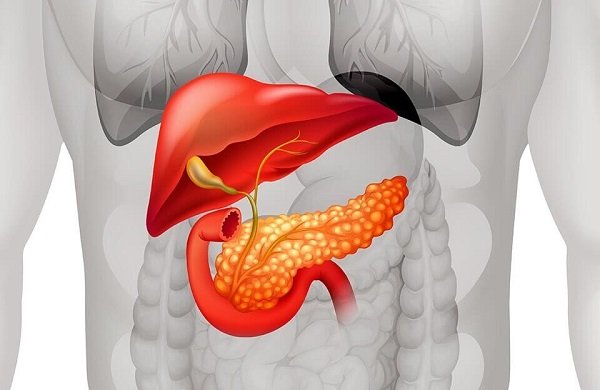
Peel 3 medium apples, cut them into large slices and bake in the oven until softened. Afterwards, the fruits are removed from the oven and crushed in a blender. A glass of milk is boiled and 3 tbsp is poured into it. L. Semolina, stirring until thickened. Applesauce is mixed with semolina porridge. Separate the whites of 2 eggs and beat them, then add the mass to the cooled apple-semolina mixture, without ceasing to mix. The resulting pudding base is placed in molds and baked in the oven for 30 minutes.
Dried
Dried apples can be used as an independent dish or for making compotes. In order to dry, fruits should be washed, dried, cut into rings or slices, removing the seed capsule. Then place in an even layer on a baking sheet and place in the oven.
For the first hour, apples should be dried at a temperature of 60°C, after which the temperature is gradually increased. So, at the end of drying, after 6-10 hours, the temperature reaches 80-100°C. Every 50 minutes, the pieces of fruit on the baking sheet are mixed. The total cooking time depends on the variety and size of the pieces.
